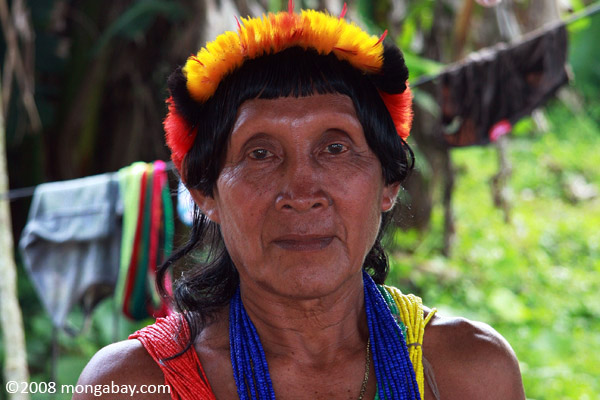
Amasina, a Trio shaman in Kwamalasamutu, Suriname. Amasisa was interviewed by mongabay.com in June 2008
Much of the Amazon rainforest remains occupied by tribal groups. While few of these live as conjured in the imagination, the state of the forests in their territories is a testament to their approach to managing lands. But like the Amazon itself, these groups face new pressures from the outside world. For the indigenous, the lure of urban culture is strong—cities seem to offer the promise of affluence and the conveniences of an easy life. But in leaving their forest homes indigenous peoples are usually met with a stark reality: the skills that serve them so well in the forest don’t translate well to an urban setting. The odds are stacked against them; they arrive near the bottom of the social ladder, often not proficient in the language and customs of city dwellers. The lucky ones may find work in factories or as day laborers and security guards, but many eventually return to the countryside. Some re-integrate into their villages, others return in a completely different capacity than when they departed. They may join the ranks of miners and loggers who trespass on indigenous lands, ferreting out deals that pit members of the same tribe against each other in order to exploit the resources they steward. As tribes are fragmented, and forests fall, indigenous culture—and the profound knowledge contained within—is lost. The world is left a poorer place, culturally and biologically.

In Rondonia, Brazil, Surui you use ACT-provided laptops to monitor their reserve using Google Earth technology. Photo © Fernando Bizerra Jr.
But there is new hope, embodied by efforts to enable tribes to become more self-reliant through the use of state-of-the-art technology that builds on and leverages their traditional knowledge. These tools can help them better defend their lands and offer the potential for the next generation of Surui, Trio, or Ikpeng to have a future of their determination rather than one dictated to them by a society that values the resources locked in their territories over their forest knowledge and rich cultural history. Through such technology, tribes may be able to avoid a fate in which they become destroyers, rather than protectors, of the basis of their culture—their forest home.
Ethnographic maps built using cutting-edge technology may help Amazon tribes win forest carbon payments
More reading
Amazon Indians use Google Earth, GPS to protect forest home
Indians are key to rainforest conservation efforts says renowned ethnobotanist